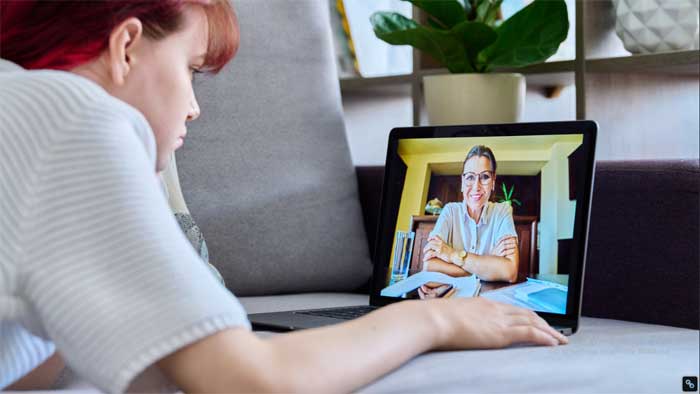In today’s fast-paced world, prioritizing mental wellness has become more crucial than ever before. The pursuit of mental well-being has given rise to various innovative approaches, one of which is video therapy. The concept of using videos for therapeutic purposes might sound unconventional, but it holds immense promise in positively impacting our emotional and psychological states. This article delves into the intriguing world of video therapy, exploring its science, benefits, and practical applications to enhance our mental wellness journey.

Image Credit: lifebing
Contents
Significance of Mental Wellness in Today’s World
In the fast-changing and connected world, we live in, the importance of mental wellness has never been more pronounced. Amidst the hustle and bustle of daily life, our mental health often takes a backseat to the demands of work, social obligations, and personal responsibilities. As a result, an alarming increase in stress, anxiety, and other mental health challenges can have far-reaching implications on our overall well-being.
The pressure to excel in various aspects of life, coupled with the constant influx of information through digital channels, can create a sense of overwhelm. From the pressures of academia and the workforce to the expectations of maintaining a vibrant social life, the modern individual finds themselves navigating a complex web of demands. Neglecting mental wellness in this whirlwind of activities can lead to a range of consequences, affecting not only our emotional state but also our physical health and relationships.
The fast-paced nature of our world has also made it challenging to fully disconnect and unwind. The boundary between work and personal time is increasingly blurred, leaving us in a constant state of alertness and stress. Recognizing the importance of mental wellness is the first step towards reclaiming a sense of balance and inner calm. It’s about acknowledging that our minds, just like our bodies, require care, attention, and the tools to navigate the challenges that life presents.
The Concept of Using Videos for Therapeutic Purposes
As technology evolves, so do the ways we approach mental health. Video therapy, a novel approach, involves using carefully curated videos to promote relaxation, emotional balance, and overall mental wellness. While it might seem unconventional, the therapeutic power of videos is backed by science and positive real-life experiences.
Understanding Video Therapy
Video therapy involves connecting with a licensed mental health professional through virtual platforms. It’s an evolution of traditional therapy that offers convenience and accessibility. This mode of therapy breaks down geographical barriers, allowing people to access help from the comfort of their own spaces.
1. Exploring the Idea of Video Therapy:
Video therapy harnesses the potential of technology to create a personal and confidential therapeutic environment. Clients can engage in sessions while being in a familiar setting, promoting a sense of security and openness.
2. Positive Impact on Mental Health:
Research suggests that video therapy can have positive effects on mental well-being. Visual and auditory cues enhance communication, allowing therapists to better understand and address their clients’ concerns. Additionally, the flexibility of video sessions encourages more frequent engagement, leading to consistent progress.
3. Visual and Auditory Stimuli in Emotional Well-being:
Visual and auditory stimuli play a crucial role in influencing emotions. Video therapy capitalizes on this connection by enabling therapists to observe non-verbal cues and tone of voice, facilitating a deeper comprehension of clients’ emotions.
The Science Behind Video Therapy
The emergence of video therapy has not only expanded accessibility but also tapped into the fascinating science of human cognition and emotion regulation. Let’s delve into the neurological intricacies that make video therapy a powerful tool for relaxation and healing.
1. Neurological Basis of Video-Induced Relaxation:
Video therapy capitalizes on the brain’s response to visual stimuli. When individuals engage with calming videos, their brains release neurotransmitters like dopamine and serotonin, which are associated with pleasure and relaxation. This response contributes to an overall sense of ease and tranquility, making video therapy conducive to therapeutic outcomes.
2. Influence of Videos on Stress Hormones and Brain Activity:
Studies reveal that watching soothing videos can lead to reduced levels of stress hormones such as cortisol. As individuals immerse themselves in visually pleasing content, the brain’s amygdala, responsible for processing emotions, registers a decrease in activity. This calming effect can be harnessed to alleviate anxiety and tension during video therapy sessions.
3. Research Findings on the Effectiveness of Video Therapy:
Research examining the efficacy of video therapy has yielded promising results. The visual and auditory elements of video sessions allow therapists to establish rapport and connection, mirroring in-person interactions. Moreover, the convenience of virtual therapy promotes consistent engagement, leading to sustained progress in managing various mental health concerns.
Unveiling the Benefits of Video Therapy
The realm of mental health support has undergone a remarkable transformation with the advent of video therapy. This innovative approach capitalizes on technology to provide a range of advantages that have revolutionized the way individuals seek and receive therapeutic interventions.
1. Accessibility and Convenience of Video Content:
Video therapy transcends geographical limitations, enabling individuals to connect with therapists from across the globe. This accessibility is a game-changer, especially for those living in remote areas or with limited mobility. The virtual format also eliminates the need for commuting, making therapy more feasible for busy schedules.
2. Versatility in Catering to Different Emotional Needs:
One of the standout features of video therapy is its adaptability. Different emotional needs can be addressed through tailored content, whether it’s relaxation techniques, mindfulness exercises, or coping strategies. The visual and auditory components enhance the impact of these interventions, providing a holistic approach to emotional well-being.
3. Non-invasive Nature of Video-Based Interventions:
Video therapy offers a non-intrusive platform for individuals who might feel uncomfortable with face-to-face interactions. This can be particularly beneficial for those dealing with social anxiety or other conditions that make in-person sessions challenging.
4. Rapid Relief During Times of Distress:
During moments of acute distress or crisis, video therapy can offer rapid relief. Immediate access to calming videos or guided breathing exercises can help individuals regain a sense of control and manage their emotions effectively.
Types of Therapeutic Videos
In the realm of mental health and self-care, therapeutic videos have emerged as a captivating and effective tool. These videos, designed to evoke specific emotional responses and promote well-being, come in various forms, each catering to different aspects of our emotional landscape.
1. Guided Meditation Videos and Their Calming Effects:
Guided meditation videos are a cornerstone of therapeutic content. These videos offer individuals a guided journey into relaxation and mindfulness, helping to alleviate stress and anxiety. By combining soothing visuals with calming narration, these videos create a serene mental space that facilitates inner peace and self-awareness.
2. Nature and Relaxation Videos for Inducing Serenity:
Nature has an innate ability to soothe the mind, and nature-themed relaxation videos harness this power. Through picturesque scenes of forests, oceans, and landscapes, these videos transport viewers to a tranquil realm, reducing tension and inducing a sense of serenity. They’re particularly effective in providing a mental escape from the demands of daily life.
3. Motivational and Inspirational Videos for Fostering Resilience:
Therapeutic videos extend beyond relaxation; they can also inspire and empower. Motivational and inspirational videos combine uplifting visuals with powerful narratives to boost resilience and motivation. These videos remind individuals of their strengths, fostering a positive mindset and encouraging them to overcome challenges.
There are numerous instances when therapists can create inspirational videos and edit them with an online video editor to make them more personalized and relatable in order to keep their clients engaged.
Crafting Your Ideal Therapeutic Video Playlist
In the modern age of digital well-being, curating a personalized collection of therapeutic videos has become a powerful practice for enhancing mental health. Building a video playlist tailored to your emotions and needs can be a transformative self-care tool.
1. Creating a Personalized Collection of Therapeutic Videos:
Assembling a video playlist is akin to curating a gallery of emotions. Select videos that resonate with you on a personal level, whether they evoke calmness, motivation, or introspection. The process of curating itself can be therapeutic, allowing you to explore your emotional landscape.
2. Matching Videos to Specific Emotions or Needs:
Diverse emotions require a diverse collection of videos. When sadness or anxiety looms, turn to videos that offer solace and relaxation. On days when motivation is lacking, seek out inspiring videos that ignite your inner drive. Tailoring your playlist to your current emotional state can provide a powerful avenue for catharsis and growth.
3. Importance of Diversity in Video Content:
Variety is key to a well-rounded playlist. Incorporating different themes, styles, and perspectives ensures that you have a range of options at your disposal. A mix of guided meditations, nature scenes, and motivational talks can address the multifaceted nature of human emotions.
Enhancing Your Daily Routine with Therapeutic Videos
Incorporating therapeutic videos into your daily routine can be a game-changer in promoting mental well-being. These visual delights offer a versatile and accessible means to manage stress, boost positivity, and improve sleep. Let’s explore how you can seamlessly integrate these videos into different segments of your day.
1. Utilizing Videos in Morning Routines for a Positive Start:
Start your day on a positive note by incorporating therapeutic videos into your morning routine. Engage with videos that inspire and motivate, setting a harmonious tone for the rest of the day. Whether it’s a short meditation, an affirmation video, or a picturesque nature scene, these videos can help you kick-start your day with vitality.
2. Midday Breaks with Calming Videos to Reduce Stress:
As the day progresses, taking short breaks to unwind is crucial. During midday pauses, turn to calming videos that offer a mental escape from work-related stress. A few minutes of watching serene landscapes or engaging in breathing exercises can reset your mind and boost productivity.
3. Relaxing with Videos Before Bedtime for Improved Sleep:
Incorporating therapeutic videos into your bedtime routine can lead to improved sleep quality. Opt for relaxing visuals that induce tranquility, helping you unwind from the day’s demands. Guided sleep meditations and gentle sounds of nature can lull you into a peaceful slumber.
Elevating Video Therapy with Complementary Practices
Video therapy has proven to be a valuable asset in the realm of mental health support. However, its potential can be further amplified when combined with other mindful practices. By integrating therapeutic videos into various activities, you can create a holistic approach to nurturing your emotional well-being.
1. Combining Videos with Mindfulness Practices:
Pairing therapeutic videos with mindfulness techniques can deepen your emotional experience. Engaging in meditation while watching calming visuals can enhance your sense of presence and self-awareness. This synergy allows you to tap into the power of both visual stimuli and mindful introspection.
2. Integrating Videos with Journaling and Reflection:
Enhance your self-discovery journey by incorporating videos into journaling and reflection sessions. After watching a video that resonates with you, take a few moments to write down your thoughts, emotions, and insights. This fusion of visual inspiration and introspection can lead to profound personal growth.
3. Incorporating Videos into Physical Activities for a Holistic Approach:
Video therapy need not be confined to static moments. Infuse movement into your therapy by engaging in physical activities while watching relevant videos. Whether it’s yoga, stretching, or mindful walking, syncing your body’s motions with therapeutic visuals can create a harmonious mind-body connection.
Professional Mental Health Support Through Video Sessions
The digital age has ushered in a new era of accessibility, especially in the realm of mental health support. With the availability of licensed therapists through online video sessions, individuals now have unprecedented access to professional help that was once limited by geographical barriers.
1. Availability of Licensed Therapists Through Online Sessions:
Video communication has broken down traditional barriers to seeking therapy. Now, regardless of where you reside, you can connect with skilled therapists who understand your concerns and offer guidance. Online sessions provide a confidential and convenient platform to discuss your challenges and work towards mental well-being.
2. Accessible Mental Health Support via Video Communication:
The ability to access mental health support through video communication is a significant advancement. This mode of therapy eliminates the need for commuting and waiting rooms, making it particularly valuable for individuals with busy schedules or mobility constraints. It democratizes mental health care, ensuring that everyone can seek the help they deserve.
Ethical Consumption of Therapeutic Video Content
In the digital age, our choices in video consumption have a direct impact on our mental well-being. Practicing ethical consumption of therapeutic video content involves being mindful of the content we engage with and prioritizing our emotional health.
1. Choosing Videos that Promote Positivity and Well-Being:
Selecting videos that uplift and inspire is essential. Seek content that aligns with your emotional goals, whether it’s guided meditation, motivational talks, or relaxing nature scenes. These videos can nurture a positive mindset and contribute to your overall well-being.
2. Avoiding Triggering Content that Exacerbates Distress:
Being aware of your triggers and avoiding content that exacerbates distress is crucial. While confronting challenges is part of personal growth, intentionally exposing yourself to triggering material can be detrimental. Opt for videos that empower you without compromising your emotional stability.
3. Respecting Privacy and Consent in Video Therapy:
In the realm of video therapy, ethical considerations are paramount. Ensuring your privacy and giving informed consent to share personal information are fundamental. Likewise, therapists must uphold ethical standards by safeguarding client confidentiality and respecting boundaries within the virtual therapeutic space.
Embarking on a video therapy journey can be transformative, yet like any path to growth, it comes with its share of challenges. From maintaining consistency to facing setbacks, here’s how you can navigate these hurdles while nurturing your emotional well-being.
1. Maintaining Consistency in Video Therapy:
Consistency is key to reaping the benefits of video therapy. Amid life’s demands, it’s easy to let sessions slide. Set a regular schedule and treat video therapy appointments with the same dedication as in-person ones. This commitment ensures that you consistently invest in your mental health.
2. Embracing Setbacks and Treating Oneself with Compassion:
Challenges and setbacks are natural parts of any healing journey. If you miss a session or experience a setback, remember that progress is not linear. Approach yourself with compassion and understanding. Acknowledge your efforts and view setbacks as opportunities for growth, rather than reasons to feel defeated.
Measuring Progress and Reaping the Benefits of Video Therapy
As you engage in the world of video therapy, it’s important to recognize and measure the progress you’re making. By tracking emotional changes and evaluating the impact of video therapy over time, you can truly appreciate the benefits it brings to your mental well-being.
1. Tracking Emotional Changes and Improvements:
Keep a journal or record of your emotional state before and after video therapy sessions. Note any shifts in mood, stress levels, or overall outlook. Tracking these changes can help you pinpoint patterns and identify the techniques or videos that have the most positive impact on your emotional state.
2. Evaluating the Effectiveness of Video Therapy Over Time:
Regularly assess your overall well-being and compare it to the state you were in before starting video therapy. Take note of improvements in coping mechanisms, resilience, and emotional regulation. This evaluation will not only showcase the effectiveness of video therapy but also provide motivation to continue your journey toward better mental health.
Real-Life Impact of Video Therapy: Stories of Transformation
The impact of video therapy goes beyond theory; it’s a powerful tool that has brought about profound positive changes in the lives of many. Through the testimonials of individuals who have benefited, we can witness firsthand the transformative potential of this innovative approach to mental health support.
1. Sharing Testimonials from Individuals Who Have Benefited:
Hearing the voices of those who have experienced the benefits of video therapy is a testament to its efficacy. These individuals share their journeys of overcoming challenges, finding strength, and discovering new perspectives. Their stories serve as beacons of hope for anyone considering embarking on their own video therapy journey.
2. Personal Stories of Transformation Through Video Therapy:
Personal narratives highlight the real-life impact of video therapy. Stories of individuals who have battled anxiety, depression, or other mental health concerns and have experienced significant improvements are inspiring. They underscore the importance of seeking help, embracing change, and believing in the transformative potential of therapeutic videos.
Conclusion
As we conclude, it’s important to embrace the potential of video therapy in our daily lives. Whether you’re seeking relaxation, motivation, or personal reflection, curated video content can be seamlessly integrated into your self-care routine. By doing so, you prioritize your mental well-being, nurturing a more balanced and resilient you.
Incorporating therapeutic videos into your life is a choice to invest in your emotional health. As technology continues to advance, this avenue of support stands as a testament to the profound impact that visual and auditory experiences can have on our journey to enhanced mental wellness.


